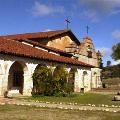
California Missions – San Antonio de Padua
Founded: July 14, 1771 – Third of the California Missions
Special Designation: Mission of the Sierras
Named For: Saint Anthony of Padua, a thirteenth century Franciscan, the finder of lost possessions
Mission Site: Located in the Santa Lucia Mountains in an oak studded valley southeast of Monterey, on a what is presently a military reservation. The setting of this mission is much as a traveler would have seen two centuries ago.
Layout: Traditional quadrangle, largely restored by W.R. Hearst and the Franciscans between 1948 and 1952.
Special Attraction: The extensive restoration and unspoiled setting of San Antonio de Padua makes this one of the most picturesque missions in California. It has an extensive museum with a number of exhibits displaying various aspects of daily life at the mission. The site also boasts the most complete, and largely unrestored, Mission-era water control system in California.
Current Status: A retreat center.
Full Post
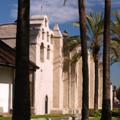
California Missions – San Gabriel Arcángel
Founded: September 8, 1771 – Fourth of the California Missions
Special Designation: Pride of the Missions
Named For: Gabriel, Holy Prince of Archangels
Also Called: Mission San Gabriel
Mission Site: The mission was originally established along the slopes of the Montebello hills at the native site of Shevaanga, overlooking the San Gabriel Valley. In 1775 the mission was relocated to the native site of Iisanchanga “about a league” (3 miles) to the northwest. This mission is 9 miles east of downtown Los Angeles.
Layout: Traditional quadrangle, with soldier’s barracks, neophyte housing, warehouses, and other structures (forming a second incomplete quadrangle) extending out from the central compound.
Mission Church: The unique San Gabriel church, completed in 1805, features a Moorish, “fortress-like” appearance, with capped buttresses and long narrow windows along the prominent side wall. The style is similar to the Cathedral in Cordova Spain.
Current Status: Active Roman Catholic Church of the Archdiocese of Los Angeles.
Full Post
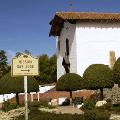
California Missions – San José
Founded: June 11, 1797 – The Fourteenth of the California Missions
Named For: Saint Joseph, husband of Mary, the mother of Jesus
Also Called: The Mission of the Most Glorious Patriarch Saint Joseph
Mission Site: In Fremont, 15 miles northeast of the pueblo (and current city) of San Jose.
Layout: The layout was more of a rectangle than the traditional quadrangle
Mission Church: The simple but powerful San José church is a restoration of the 1809 church, which was destroyed in an earthquake in 1868. The authentic restoration was completed during 1982-85.
Current Status: An active church that is part of Saint Joseph’s Parish.
Full Post
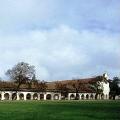
California Missions – San Juan Bautista
Founded: June 24, 1797 – The 15th of the California Missions
Special Designation: Mission of Music
Named For: St. John the Baptist
Also Called: La Misión del Glorioso Precursor de Jesu Cristo, Nuestro Señor San Juan Bautista (The Mission of the Glorious Precursor of Jesus Christ, Our Lord San Juan Bautista)
Mission Site: Located on the main plaza in the town that developed around the mission, some 90 miles southeast of San Francisco.
Mission Church: The present church was dedicated on June 23, 1812, and replaced the much smaller adobe chapel of 1797-98 built by Ygnacio Barrera, Second Carpenter of the frigate Concepción. In 1818 Anglo-American carpenter Felipe Santiago (Thomas Doak), the earlies American settler in California, painted (and very likely constructed) the main altar reredos after a design by Fr. Estevan Tapis.
Special Attraction: San Juan Bautista offers the best opportunity to see and appreciate the California of 160 years ago. There are some 30 historic buildings in the 12-block area surrounding the Spanish Plaza (the only original one remaining in the state) including the Mission’s original adobe manjerio (nunnery), since renamed Plaza Hall and the fomer cuartel (Soldier’s barracks) retrofitted by Angelo Zanetta in 1858 as the Plaza Hotel.
Current Status: Active Catholic church since 1797, now under the Roman Catholic Diocese of Monterey. The existing adobe church has seen continuous use since 1812.
Full Post
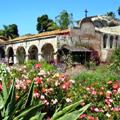
California Missions – San Juan Capistrano
Founded: November 1, 1776 – The Seventh of the California Missions
Special Designation: Pride of the Missions
Named For: St. John of Capistrano, a 14th century theologian
Mission Site: Located within sight of the ocean in the town of San Juan Capistrano, which developed around the mission.
Layout: Traditional quadrangle
Mission Church: In 1778, two years after the mission was moved to the present site, a small adobe chapel was built, and soon replaced by the Serra Chapel in 1782. This is the only remaining church in which Fr. Serra held mass. In order to accommodate the mission’s growing population, the Great Stone Church was constructed between 1797 – 1806. This cathedral-like building was 180 feet long by 40 feet wide, and had a high-vaulted ceiling surmounted by seven domes fronted by a 120 foot tall bell tower. In December, 1812 a massive earthquake destroyed the Great Stone Church, killing 40 neophytes.
Special Attraction: San Juan Capistrano, with its beautifully landscaped grounds and with the ruins of the
Great Stone Church and adjacent bell wall, is one of the most picturesque sites in California.
Current Status: The Mission San Juan Capistrano Basilica (a large modern church) and the Serra Chapel are part of the Catholic Parish of San Juan Capistrano.
Full Post
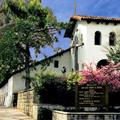
California Missions – San Luis Obispo de Tolosa
Founded: September 1, 1772 – 5th of the California Missions
Named For: St. Louis, Bishop of Toulouse, France, a 14th century Franciscan
Also Called: Mission San Luis Obispo
Mission Site: Located in a spacious valley along the central coast which the Spanish named “La Cañada de los Osos” (Valley of the Bears) when they discovered many grizzlies there. Unlike many of the missions which we re-situated over time, San Luis Ob?spo stands on its original site.
Layout: Traditional quadrangle
Mission Church: The San Luis Ob?spo church was built in 1792-94. The prominent numbers inscribed on the church facade refer to the year the mission was founded in 1772. The vestibule was added in 1820. The former convento (which now contains a museum and gift shop) has a distinctive front colonnade of eleven round columns set on square pedestals.
Special Attraction: The mission has an excellent museum with a special room that focuses on the Chumash Indians. The adjacent plaza is a popular site for community events. A stream runs through the area.
Current Status: Central parish church for city of San Luis Obispo.
Full Post
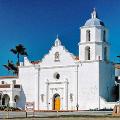
California Missions – San Luis Rey de Francía
Founded: June 13, 1798 – The 18th of the California Missions
Special Designation: King of the Missions
Named For: King Luis IX of France, who led crusades to the Holy Land in the 13th century.
Also Called: Mission San Luis Rey
Mission Site: Located on a hill overlooking a peaceful valley at the native village of Tacayme in the region know as Quechia, about five miles east of present day Oceanside.
Layout: San Luis Rey extended over six acres. By 1826 the quadrangle measured 500 feet on each side. There was a long corridor with thirty-two Roman arches in front of the patio.
Mission Church: The San Luis Rey Church, completed in 1815, is the only surviving mission church laid out in a cruciform plan. It is 165.5 feet in length and the nave spans 27.5 feet in width by 30 feet in height. A cupola – unique among the California missions – is an octagonal lantern formed of 144 panes of glass. It tops the wooden dome built over the sanctuary in 1829.
Special Attraction: The sunken garden and lavanderia (laundry), located in a hollow to the south of the mission may be reached by descending 46 fire tiled steps. Two springs provided water that sprouted from the mouths of sculpted gargoyles into the lavanderia.
Current Status: A consecrated Roman Catholic church attached to the Franciscan community of San Luis Rey de Francia.
Full Post
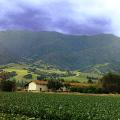
California Missions – Nuestra Señora de la Soledad
Mission Soledad deteriorated rapidly after secularization. It served for several years as the Felilano Soberanes ranch house, a grocery store and a restaurant and was then abandoned for almost 100 years. The Daughters of the Golden West restored the chapel in 1953, and the convento wing (present day museum) in 1963
Founded: October 9, 1791 – Thirteenth of the California Missions
Named For: Our Lady of Solitude (Also Called Soledad Mission)
Mission Site: Thirty miles southeast of Monterey in the Salinas River Valley at a site thought to have been an Esselen village known by the natives as Chuttusgelis.
Layout: A courtyard-centered quadrangle with out-buildings. Neophyte housing was located to the south and the cemetery to the east.
Special Attraction: The grounds, which still contain the ruins of the mission’s adobe walls, are a haunting reminder of how difficult life must have been at this remote and desolate mission.
Current Status: A chapel of Our Lady of Solitude Catholic Church is in the town of Soledad
Full Post
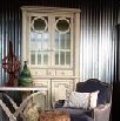
Top Current Home Decor Trends
Something old, something new. Something borrowed, something blue… this adage holds equally true for the top home decorating trends.
What’s old is new again
Whether they’re genuine period pieces being repurposed or home furnishings reproduced from popular items from the ’50s, ’60s or ’70s, vintage is hot. Examples include chair frames redone in new upholstery, and traditional lighting fixtures in newer brass or pewter finishes.
A spectrum of colors
Color trends will carry over from the previous year with the soothing aqua and green hues that draw their inspiration from the verdigris deposits found on weathered copper statues. For outdoor furniture and accessories, sassy colors like lime green, bold orange and Caribbean blue, along with more subdued hues such as sage green, barn red and mocha brown.
The mad world of furniture
Furniture styles are returning to the ’50s and ’60s with round tapered legs on angles, geometric accents and seating with curved backs. Add to that classic wood pieces made from sentimental stock like fallen trees or scrap wood from ancestral or historic structures.
A trend that will stick around
A small change in a room can make a huge difference – and wall coverings make a dramatic, yet cost-effective statement. Innovative new SmartStick repositionable wall murals make it easy for homeowners, renters and even college students to add a fresh new look to indoor and outdoor walls, floors, doors and windows.
Green continues to be keen
As living green becomes more ingrained in our lives, LED lighting will continue to light the way. Products and materials such as bronze, copper, clay, cotton, linen and hemp – which are environmentally friendly, contribute to healthy indoor air quality, and can be repurposed or recycled at the end of their lifespan. Using such natural textures as hemp, jute, organic cotton, recycled polyester, bamboo fiber, organic wool and linen, and soy silk will help keep it simple but still green.
Full Post

A (very brief) Guide to Vienna
Vienna, the capital of Austria, boasts an impressive number of palaces, monuments and other landmarks due to its centuries-long position as the heart of the Habsburg Empire.
Most of the city’s main sights are located in Vienna’s compact center or at the boulevard encircling the historic center, which makes it easy to visit the city on foot. Other neighborhoods are easily accessible thanks to the efficient subway.
Predominant Architecture:
A variety of architectural styles can be found in Vienna, such as the Romanesque Ruprechtskirche and the Baroque Karlskirche. Styles range from classicist buildings to modern architecture. Art Nouveau left many architectural traces in Vienna, and concurrent to the Art Nouveau movement was the Wiener Moderne, during which some architects shunned the use of extraneous adornment.
Places to see:
Hofburg: An immense Imperial palace, built by generations of Habsburg rulers from the 13th century up to the early 20th century. It is home to a number of interesting museums.
Schönbrunn Palace: The favorite residence of the Habsburg family. Its Schlosspark is a magnificent park with numerous monuments and fountains.
Stephansdom: Vienna’s Cathedral, the Gothic Stephansdom, was built in the 14th century at the site of an earlier church, of which two towers were incorporated.
Karlsplatz: One of the largest squares in Vienna. Much of it is occupied by the Resselpark, where two beautiful former metro pavilions are located.
Ringstrasse: The Ringstrasse is a boulevard created in the 19th century at the site of the former city
fortifications. In a span of two decades a host of magnificent buildings were erected here.
Full Post
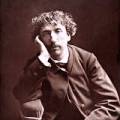
Charles Garnier (1825 – 1898)
Inspired by Roman pageantry, French architect Charles Garnier wanted his buildings to have drama and spectacle. His design for the magnificent Opera House in Paris combined the classicism of Renaissance architecture with ornate Beaux Arts ideas.
Jean Louis Charles Garnier was born into a working class family. He was expected to become a wheelwright like his father. However Garnier wasn’t healthy and his mother didn’t want him to work in a forge. So, Charles
Garnier took mathematics courses at the École Gratuite de Dessin.
After studying architecture at the École Royale des Beaux-Arts in Paris, Charles Garnier spent five years at the Academy in Rome. He was inspired by Roman pageantry and aspired to design buildings that had the drama of a pageant.
The highlight Charles Garnier’s career was his commission to design the Opéra in Paris. With its magnificent hall and grand staircase, the Opera House combined classical Renaissance ideas with lavish ornamentation. Garnier’s opulent style reflected the fashion that became popular during Napoleon III’s Second Empire.
Notable Work:
1857-1874: Opéra in Paris
1878: Casino at Monte Carlo
Bischoffsheim Villa at Bordighera
Hotel du Cercle de la Librairie in Paris